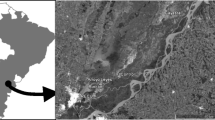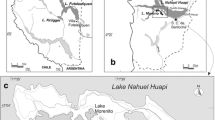Abstract
In order to reveal the actual effects of common reed (Phragmites australis (Cav) Trin. ex Steudel) and its periphyton complex on the water quality, studies on the heavy metal contents of common reed and its periphyton are important. This paper discusses the results of studies on heavy metal contents of the host plant-periphyton complex carried out in Lake Balaton, Lake Velence, Lake Fertö and Kis-Balaton Reservoir. A second goal was to study the effects of reed stands in different condition (healthy, transitional, die-back) on the structure of its periphyton and their role in water quality indication. Simultaneously with the reed and periphyton sampling, water samples were taken for investigation. We determined the wet mass of periphyton and after drying at 105 °C; the dry mass was measured and ash contents of reed and its periphyton samples were also determined. The concentration of 27 (Na, Mg, Ca, K, Zn, Cu, Cd, Cr, Pb, Mo, etc.) cations was determined from the reed, periphyton and water samples by ICP-AES method. The heavy metal content of reed and periphyton was especially high at places impacted by high anthropogenic loadings. On the basis of our results, the biofilter role of periphyton-reed complex can be confirmed. Since the main reasons of reed decline have not been revealed, future research has to focus on involving reed-periphyton studies also, which may provide good basis to find the most appropriate ways to protect and restore the reed communities of shallow standing waters.
Similar content being viewed by others
References
Allen, H. L., 1971. Primary productivity, chemo-organotrophy and nutritional interactions of epiphytic algae and bacteria on macrophytes in the littoral of a lake. Ecol. Monogr. 41: 97–127.
Armstrong, J., W. Armstrong & W. H. Van Putten, 1996. Phragmites die-back: bud and root death, blockages within the aeration and vascular systems and the possible role of phytotoxins. New Phytol. 133: 399–414.
Dinka, M., 1986. Accumulation and distribution of elements in cattail species (Typha latifolia L., T. angustifolia L.) and reed (Phragmites australis/Cav./Trin. ex Steudel) living in Balaton. Proceedings EWRS/AAB 7th Symposium on Aquatic Weeds: 81–86.
Dinka, M., P. Szeglet & I. Szabó, 1995. Hungarian Group Report. In Van Putten, W. H. (ed.) Reed News Reports of EC Project EUREED-EV5V-CT92–0083, vol. 3. Heteren, The Netherlands: Netherlands Institute of Ecology, 96–107.
Dokulil, M., 1975. Planktonic primary and bacterial productivity in shallow waters within a large Phragmites community (Neusiedlersee, Austria). Verh. int. Ver. Limnol. 19: 1295–1304.
Dokulil, M., H. Metz & D. Jewson (eds), 1980. Shallow lakes contributions to their limnology. Dr W. Junk Publishers, The Hague: 212 pp.
Dushenkov, V., P. B. A. Nanda Kumar, H. Motto & I. Raskin, 1995. Rhizofiltration: the use of plants to remove heavy metals from aqueous streams. Envir. Sci. Technol. 29: 1239–1245.
Haslam, S. M., 1978. River plants. University Press: Cambridge.
Korponai, J., K. Mátyás, G. Paulovits, I. Tátrai & N. Kovács, 1997. The effect of different fish communities on the cladoceran plankton assemblages of the Kis-Balaton Reservoir, Hungary. Hydrobiologia 360: 211–221.
Kowalczewski, A., 1965. Changes in the periphyton biomass of Mikolaiskie Lake. Bull. Acad. Pol. Sc. 13: 395–398.
Kovács, M., G. Turcsányi, Z. Tuba, S. E. Walcsánszky, T. Vásárhelyi, A. Dely-Draskovits, S. Tóth, A. Koltay, L. Kaszab, P. Szőke & B. Jankó, 1989. The decay of reed in Hungarian lakes. In Salánki, J. & S. Herodek (eds), Conservation and Management of Lakes. Symp. biol. Hung. 38: 461–471.
Kovach, W. L., 1993. MVSP Version 2.1 Users's Manual. Kovach Computing Services, Pentraeth, Wales, U.K: ii+55 pp.
Lakatos, G., 1978. The phenomenon and significance of benthonic eutrophication in Lake Velencei, Hungary. Acta Biol. Debrecina 15: 147–168.
Lakatos, G., 1983. Accumulation of elements in biotecton forming on reed (Phragmites australis) in two shallow lakes in Hungary. Proc. Int. Symp. Aquat. macrophytes, Nijmegen: 117–122.
Lakatos, G., 1989. Composition of reed periphyton (biotecton) in the Hungarian part of Lake Fertő. BFB-Bericht 71: 125–134.
Lakatos, G., 1993. Studies on heavy metals of periphyton and its host plant (Phragmites australis (Cav.) Trin. ex Steudel) in shallow lakes. Stud. Envir. Sci. 55: 365–372.
Lakatos, G. & P. Bíró, 1991. Study on chemical composition of reed-periphyton in Lake Balaton. BFB-Bericht 77: 157–164.
Lakatos, G., I. Grigorszky & P. Biró, 1998. Reed-periphyton complex in the littoral of shallow lakes. Verh. int. Ver. Limnol. 26: 1852–1856.
Mickle, A. M. & R. G. Wetzel, 1979. Effectiveness of submerged angiosperm-epiphyte complex on exchange of nutrients and organic carbon in littoral system. III. Refractory organic carbon. Aquat. Bot. 6: 339–355.
Ostendorp, W., 1989: 'Die-back' of reeds in Europe - a critical review of literature. Aquat. Bot. 35: 5–26.
Padisák, J., 1982. The periphyton of Lake Fert?: species composition and Chlorophyll a content. BFB-Bericht 43: 95–105.
Pomogyi, P., 1993. Nutrient retention by the Kis-Balaton Water Protection System. Hydrobiologia 251: 309–320.
Simonian, A., I. Tátrai, P. Bíró, G. Paulovits, L. G. Tóth & G. Lakatos, 1995. Biomass of planktonic crustaceans and the food of young cyprinids in the littoral zone of Lake Balaton. Hydrobiologia 303: 39–48.
Sommer, U., 1977. Productionsanalysen am Periphyton in Schilfgürtel des Neusiedler Sees. Sitzungsber. Österr. Akad. Wiss., mathem.-naturwiss. Kl., Abt. 1186: 219–246.
Szczepanska, W., 1970. Periphyton of several lakes of the Mazurian lakeland. Pol. Arch. Hydrobiol. 17: 397–418.
Wetzel, R. G., 1964. A comperative study of the primary productivity of higher aquatic plants, periphyton and phytoplankton in large, shallow lake. Int. Rev. ges. Hydrobiol. 49: 1–61.
Author information
Authors and Affiliations
Rights and permissions
About this article
Cite this article
Lakatos, G., Kiss, M. & Mészáros, I. Heavy metal content of common reed ( Phragmites australis /Cav./Trin. ex Steudel) and its periphyton in Hungarian shallow standing waters . Hydrobiologia 415, 47–53 (1999). https://doi.org/10.1023/A:1003817016633
Issue Date:
DOI: https://doi.org/10.1023/A:1003817016633




